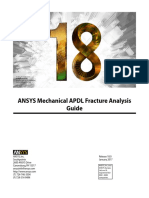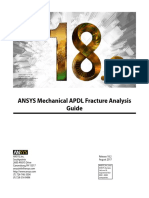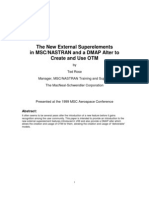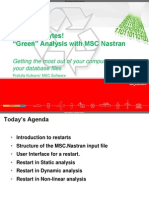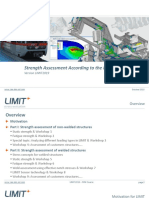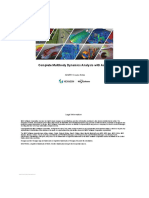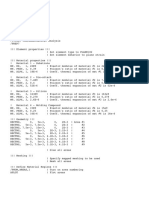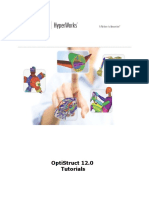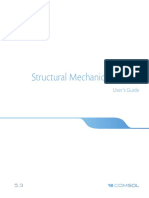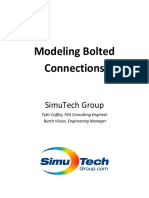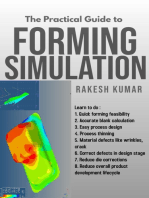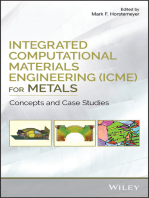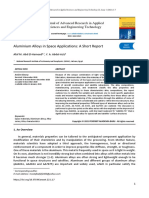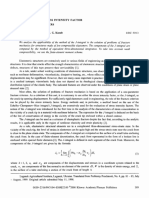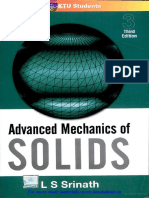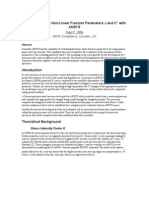0 ratings0% found this document useful (0 votes)
141 viewsFRAC W01 ThreePoint
FRAC W01 ThreePoint
Uploaded by
avenashaA crack in a Three-point Bend Specimen is subjected to Mode I loading. In this workshop, you will perform a parametric study to evaluate J and K at the crack tip using a series of different mesh configurations. The results will be compared with the theoretical value.
Copyright:
Attribution Non-Commercial (BY-NC)
Available Formats
Download as PDF, TXT or read online from Scribd
FRAC W01 ThreePoint
FRAC W01 ThreePoint
Uploaded by
avenasha0 ratings0% found this document useful (0 votes)
141 views11 pagesA crack in a Three-point Bend Specimen is subjected to Mode I loading. In this workshop, you will perform a parametric study to evaluate J and K at the crack tip using a series of different mesh configurations. The results will be compared with the theoretical value.
Copyright
© Attribution Non-Commercial (BY-NC)
Available Formats
PDF, TXT or read online from Scribd
Share this document
Did you find this document useful?
Is this content inappropriate?
A crack in a Three-point Bend Specimen is subjected to Mode I loading. In this workshop, you will perform a parametric study to evaluate J and K at the crack tip using a series of different mesh configurations. The results will be compared with the theoretical value.
Copyright:
Attribution Non-Commercial (BY-NC)
Available Formats
Download as PDF, TXT or read online from Scribd
Download as pdf or txt
0 ratings0% found this document useful (0 votes)
141 views11 pagesFRAC W01 ThreePoint
FRAC W01 ThreePoint
Uploaded by
avenashaA crack in a Three-point Bend Specimen is subjected to Mode I loading. In this workshop, you will perform a parametric study to evaluate J and K at the crack tip using a series of different mesh configurations. The results will be compared with the theoretical value.
Copyright:
Attribution Non-Commercial (BY-NC)
Available Formats
Download as PDF, TXT or read online from Scribd
Download as pdf or txt
You are on page 1of 11
Workshop 1
Crack in a Three-point Bend Specimen
Dassault Systmes, 2009 Modeling Fracture and Failure with Abaqus
Introduction
An edge crack in a three-point bend specimen in plane strain, subjected to Mode I
loading, is considered (see Figure W11). The crack length to specimen width ratio is
0.2. The length of the specimen is 55 mm, and its width is 10 mm. The material is
assumed to be linear elastic, with Young's modulus E = 2E5 MPa and Poisson's ratio
v = 0.3. The loading is in the form of bending moments applied to the ends of the
specimen. Small deformation conditions are assumed.
Figure W11 Schematic of the three-point bend specimen.
Preliminaries
1. Enter the working directory for this workshop:
../fracture/bending
2. Run the script ws_fracture_3pt_bend.py using the following command:
abaqus cae startup=ws_fracture_3pt_bend.py
This script creates an Abaqus database file named three-point-bend.cae in the
current directory. The geometry, material, step, and loading definitions for the specimen
are included in the model named focused. The bending moments are applied to the ends
of the specimen using kinematic coupling constraints. In this workshop, you will perform
a parametric study to evaluate J and K at the crack tip using a series of different mesh
configurations. The results will be compared with the theoretical value.
b=10 mm
a=2 mm
43 mm
55 mm
M =1075
Nmm
M
Dassault Systmes, 2009 Modeling Fracture and Failure with Abaqus
W1.2
Focused mesh
You will begin by considering the case of a focused mesh around the crack tip.
1. In the context bar, select focused from the Model drop-down list.
2. In the Part module, click the Partition Face: Sketch icon and sketch a
vertical line of length 2.0 mm through the center of the plate, as shown in
Figure W12. This line represents the crack. Also, sketch a circle of radius
0.5 mm centered at the crack tip. This operation creates a circular partition
around the crack tip which will facilitate swept meshing.
Figure W12 Circular partition around the crack tip
The detailed steps are outlined below:
- Sketch a vertical line through the center of the plate (using the Create
Lines: Connected tool ) then dimension it (AddDimension or
use in the toolbox).
- Edit the dimension (EditDimension or use in the toolbox) so
the length of the line is 2, as shown in the following figure.
- Sketch a circle using the Create Circle: Center and Perimeter tool
. Select the points indicated below (left) as the center and perimeter
points (the perimeter point should snap to the vertical line as indicated
by the small at the intersection of the circle and line).
- If you happen to snap the perimeter point to the midpoint of the
vertical line, you will find that an Equal distance constraint ( ) is
also created. If this happens, delete the Equal distance constraint to
avoid overconstraining the sketch.
Dassault Systmes, 2009 Modeling Fracture and Failure with Abaqus
W1.3
- Afterwards, dimension the radius of the circle, and edit its value so
that it is equal to 0.5, as shown below (right).
3. The crack-tip singularity may only be specified for independent part instances.
The part currently assumes the default dependent state. Thus, in the Model
Tree, expand the Assembly and then expand the list of instances. Click
mouse button 3 (MB3) on the instance named plate-1. In the menu that
appears, select Make Independent.
Quarter-point nodes with a single crack-tip node
To complete the model, you must define the crack and the output, generate the mesh, and
create a job.
Crack definition
1. In the Model Tree, expand the Engineering Features container underneath
the Assembly. In the list that appears, double-click Cracks.
2. In the Create Crack dialog box, select Contour integral and click Continue.
3. Select the vertex highlighted in Figure W13 as the crack front. Choose the q
vectors method to define the crack extension direction.
Figure W13 Crack front/tip
center
perimeter
Dassault Systmes, 2009 Modeling Fracture and Failure with Abaqus
W1.4
4. Select the vertices highlighted in Figure W14 as the start and end points of
the vector.
Figure W14 q vector direction
5. In the Singularity tabbed page of the Edit Crack dialog box, set the midside
node parameter to 0.25 and choose Collapsed element side, single node
as the element control. This introduces a square-root singularity at the crack
tip.
6. From the main menu bar, select SpecialCrackAssign Seam to define
the crack seam. Select the two edges indicated in Figure W15 to define the
seam (use Shift+Click to select multiple entities). The elements on either side
of this seam will not share nodes.
Figure W15 Crack seam
Output
1. In the Model Tree, double-click History Output Requests to create a contour
integral history output request. In the Edit History Output Request dialog
box, select Contour integral as the domain type, and choose the crack
defined earlier as the domain. Set the number of contours to 5 and request J-
integral output.
2. Repeat the above step, this time choosing Stress intensity factors as the
output type.
Mesh
1. In the Model Tree, expand the Instances container underneath the Assembly
and double-click Mesh underneath the instance named plate-1.
start
end
q
Dassault Systmes, 2009 Modeling Fracture and Failure with Abaqus
W1.5
2. Assign a global seed size of 1.0 to the part (SeedInstance).
3. Assign local edge seeds to the circular region surrounding the crack tip
(SeedEdge By Number):
a. Specify 16 elements along the circular edge together with the constraint
that the number of elements along this edge may only increase. The latter
constraint is not required but will improve mesh quality in this case. To
enforce the constraint, click Constraints in the prompt area after
specifying the edge seeds.
b. Specify 4 elements along the straight edge within the circular region. No
additional constraints are required.
4. Assign swept mesh controls to the circular region (MeshControls; choose
Quad-dominated as the element shape and Sweep as the technique).
5. Assign the Quad element shape using the Medial axis algorithm to the rest of
the part.
6. Assign quadratic, reduced integration plane strain elements (CPE8R) to all
regions of the plate (MeshElement Type).
7. Generate the mesh (MeshInstance). It should appear similar to the one
shown in Figure W16.
Figure W16 Part mesh: entire part (left); close up of crack tip (right)
8. Query the elements attached to the crack tip to verify that their connectivity is
that of a collapsed quadrilateral element with a repeated node at the crack tip
(ToolsQuery). For example, for the element highlighted in Figure W17,
the connectivity would be similar to that appearing at the bottom of the figure.
Dassault Systmes, 2009 Modeling Fracture and Failure with Abaqus
W1.6
Figure W17 Element connectivity at the crack tip
Job
1. In the Model Tree, double-click Jobs to create a job for this model. Name the
job cpe8r-constrain-qtr.
2. Click MB3 on the job name and select Submit from the menu that appears. In
the same menu, you may also select Monitor to monitor the progress of the
job and Results to automatically open the output database file for this job
(cpe8r-constrain-qtr.odb) in the Visualization module.
Results
1. When the job is complete, open cpe8r-constrain-qtr.odb in the
Visualization module. Evaluate the deformed shape and stress state in the part.
The deformed model shape (PlotDeformed Shape) and Mises stress
distribution (PlotContoursOn Deformed Shape) are shown in Figure
W18 and Figure W19 (using a deformation scale factor of approximately
250). The stress state is highly localized in the vicinity of the crack tip. Away
from the crack tip, the stress state exhibits the pattern characteristic of pure
bending (Figure W110 shows the longitudinal stress S11).
Tip: To change the contour plot variable, select ResultField Output from
the main menu bar and choose the appropriate variable for contouring.
Alternatively, use the Field Output toolbar.
Figure W18 Deformed model shape
Dassault Systmes, 2009 Modeling Fracture and Failure with Abaqus
W1.7
Figure W19 Mises stress distribution
Figure W110 Longitudinal stress distribution (S11)
2. Next, identify the domains for each contour. In the Results Tree, expand the
Node Sets container underneath the output database named cpe8r-
constrain-qtr.odb; double-click any set beginning with H-OUTPUT. The
five contour domains are shown in Figure W111. Note that each successive
contour domain contains the previous domain within its boundaries.
Figure W111 Contour integral domains
3. For each contour, plot the J-integral and the K
I
values:
a. In the Results Tree, click mouse button 3 on the History Output
container. From the menu that appears, select Filter.
b. In the filter field, enter J-int* to restrict the history output to just the J-
integral data.
c. Select all curves of the form J-integral: J at H-OUTPUT-*, and click
mouse button 3; from the menu that appears, select Plot.
d. Similarly, select and plot all curves of the form Stress intensity factor
K1: K1 at H-OUTPUT-* (filter the container according to Stress*).
Dassault Systmes, 2009 Modeling Fracture and Failure with Abaqus
W1.8
The results appear in Figure W112. As is seen in the figure, the values have
converged and exhibit path independence.
Note: Double-click the Y-axis in the curves to adjust the axis limits.
Figure W112 J-integral and K
I
values
4. Even though the differences in the values of J (and K) for each contour appear
to be small, common practice dictates that the first (and sometimes the
second) contour value be neglected to prevent adverse numerical effects due
to the singularity from influencing the interpretation of the results. Thus,
compute the average value of K
I
for contours 3-5 and enter the value in Table
W11.
Tip: To readily compute the average value, select the three curves indicated
above in the Results Tree, and click mouse button 3. From the menu that
appears, select Save As. In the Save XY Data As dialog box, select Average
as the operation that should be performed prior to saving the data. Then query
the data (ToolsQuery; select Probe Values in the Query dialog box).
Analysis case KI (MPa\mm)
Theoretical 170. 24
Element type Midside node
parameter
Crack tip: Single or
duplicate nodes
Singularity
CPE8R (focused) 0.25 Single node
1/\r
CPE8R (focused) 0.25 Duplicate nodes
A/r + B/\r
CPE8R (focused) 0.5 Single node none
CPE8R (unfocused) 0.25 Single node
1/\r (along edges)
CPE8R (unfocused) 0.5 Single node none
Table W11 K
I
values for parametric study
Dassault Systmes, 2009 Modeling Fracture and Failure with Abaqus
W1.9
Quarter-point nodes with independent crack-tip nodes
Edit the crack definition and select Collapsed element side, duplicate nodes as the
element control to allow each crack-tip element to possess independent crack-tip nodes.
Regenerate the mesh. Create a new job named cpe8r-indep-qtr and run the job.
Evaluate the results and enter the average value of K
I
for contours 3-5 in Table W11.
Mid-point nodes with a single crack-tip node
Edit the crack definition and select Collapsed element side, single node as the element
control and set the midside node parameter to 0.5. Regenerate the mesh. Create a new
job named cpe8r-constrain-half and run the job. Evaluate the results and enter the
average value of K
I
for contours 3-5 in Table W11.
Unfocused mesh
You will now use an unfocused, rectangular mesh to analyze the problem. Begin by
copying the model named focused to one named unfocused. All subsequent
instructions apply to the unfocused model.
Rectangular second-order mesh
Edit the part features to remove the circular face partition created at the beginning of this
exercise.
Tip: In the Model Tree, expand the Parts container. In the list of features underneath the
plate, double-click Partition face-1. In the Edit Feature dialog box, click Edit Section
Sketch. In the toolbox, click the Delete Entities tool and select the circle as the
feature to be deleted.
In the Interaction module, redefine the seam and the crack front (reselect the crack tip,
and set the midside node parameter equal to 0.25 using no degeneracy).
In the Mesh module, delete all edge seeds ( ) and assign a global seed size of 1.0 to
the entire part and element type CPE8R to all regions. Also assign the Quad element
shape using the Medial axis algorithm using the mesh controls ( ). Re-mesh the part.
Create a new job named cpe8r-unfocused-qtr and run the job. Evaluate the results
and enter the average value of K
I
for contours 3-5 in Table W11.
Change the midside node parameter to 0.5 and create a new job named cpe8r-
unfocused-half. Run the job, evaluate the results, and enter the average value of K
I
for contours 3-5 in Table W11.
Save your model database file.
Dassault Systmes, 2009 Modeling Fracture and Failure with Abaqus
W1.10
Theoretical result
The theoretical result from Tada, Paris, and Irwin (1985) for a / b < 0.6 gives:
( )
( ) ( ) ( ) ( ) ( )
2
2 3 4
6
1.122 1.40 7.33 13.08 14.0
I
M
b
a
K aF
b
a a a a a
F
b b b b b
o
o t
=
=
= + +
Discussion
The results of the simulations are summarized in Table W12 below.
Analysis case KI (MPa\mm)
Theoretical 170. 24
Element type Midside node
parameter
Crack tip: Single or
duplicate nodes
Singularity
CPE8R (focused) 0.25 Single node
1/\r 170.63
CPE8R (focused) 0.25 Duplicate nodes
A/r + B/\r 170.63
CPE8R (focused) 0.5 Single node none 170.18
CPE8R (unfocused) 0.25 Single node
1/\r (along edges) 170.46
CPE8R (unfocused) 0.5 Single node none 165.66
Table W12 K
I
values for parametric study (results)
Dassault Systmes, 2009 Modeling Fracture and Failure with Abaqus
W1.11
The focused mesh results show excellent agreement with the theoretical results for K and
J. Note that the mesh with quarter-point nodes and a single crack-tip node introduces a
1/\r singularity into the crack-tip elements. Since this problem is governed by LEFM and
the strength of this singularity is consistent with LEFM, a high degree of accuracy is
expected. For most practical problems, however, the exact form of the singularity cannot
always be represented. As noted in the lecture, a stronger form than necessary is
recommended in these cases. As shown in this example, when a stronger form of the
singularity is used (by permitting the crack-tip nodes to behave independently), very
accurate results are indeed obtained.
If the singularity is not explicitly modeled, mesh refinement can be used to obtain
accurate results. In this example accurate values of K and J were obtained in the absence
of a singularity when the mesh was focused (i.e., refined). When the meshes were coarse
(as in the case of the unfocused meshes), the singularity introduced by the quarter-point
nodes significantly improved the estimates of K and J. Thus, the benefit of the singularity
is most apparent for coarse meshes.
For all cases, the overall accuracy of the near-tip stress and strain fields is enhanced by
including a singularity in the mesh. Singular meshes tend to do a better job capturing the
steep gradient in the asymptotic stress and strain fields ahead of the crack tip. In addition,
the singularity is necessary to achieve mesh convergence of the stress and deformation
fields. The near-tip fields of a coarse mesh with a singularity will converge more rapidly
than those of a finer mesh without a singularity.
Note: A script that creates the complete model described in these instructions
is available for your convenience. Run this script if you encounter difficulties
following the instructions outlined here or if you wish to check your work. The
script is named ws_fracture_3pt_bend_answer.py and is available using the
Abaqus fetch utility.
You might also like
- ANSYS Mechanical APDL Fracture Analysis GuideDocument134 pagesANSYS Mechanical APDL Fracture Analysis Guidearulrajasi0% (1)
- Chapters 1 To 4Document108 pagesChapters 1 To 4Andreu1287100% (1)
- K.-F Arndt, M. D. Lechner Eds. Polymer Solids and Polymer Melts-Mechanical and Thermomechanical Properties of PolymersDocument634 pagesK.-F Arndt, M. D. Lechner Eds. Polymer Solids and Polymer Melts-Mechanical and Thermomechanical Properties of Polymersvuong100% (5)
- MSC Nastran 2021.4 Superelements and Modules User GuideDocument1,014 pagesMSC Nastran 2021.4 Superelements and Modules User GuideOliver RailaNo ratings yet
- External Super Element NastranDocument22 pagesExternal Super Element Nastranyans77No ratings yet
- Abaqus Orphan MeshDocument22 pagesAbaqus Orphan MeshMasoud GhodratiNo ratings yet
- Tutorial 9 Calculate Occupant Injury CriterionDocument6 pagesTutorial 9 Calculate Occupant Injury Criterionarthurs9792No ratings yet
- Py FoamDocument9 pagesPy FoamArathoNNo ratings yet
- Crack WiseDocument210 pagesCrack Wisetgrclarke100% (1)
- Mathcad - Fatigue Failure Example - 3 PDFDocument39 pagesMathcad - Fatigue Failure Example - 3 PDFnonton gaconNo ratings yet
- ANSYS Mechanical APDL Fracture Analysis GuideDocument134 pagesANSYS Mechanical APDL Fracture Analysis GuidePanda Hero100% (1)
- Stress Intensity Factors HandbookDocument26 pagesStress Intensity Factors HandbookJad Antonios Jelwan0% (1)
- ASTM E1820-20bDocument65 pagesASTM E1820-20bAnrStukNo ratings yet
- Bolt Analysis Using ABAQUSDocument23 pagesBolt Analysis Using ABAQUSsivabharath4488% (8)
- Workshop 1 Importing and Editing an Orphan Mesh: Pump Model: 这个实例中要用到的 cad 模型文件和脚本文件都可以在 abaqus 的Document36 pagesWorkshop 1 Importing and Editing an Orphan Mesh: Pump Model: 这个实例中要用到的 cad 模型文件和脚本文件都可以在 abaqus 的mrengineerNo ratings yet
- Ansys ManualDocument94 pagesAnsys Manualgmahaadev100% (3)
- HM Abaqus 1of2Document25 pagesHM Abaqus 1of2thiyakiNo ratings yet
- Other Analysis Program InterfacesDocument62 pagesOther Analysis Program InterfacesMSC Nastran Beginner100% (1)
- The New External Superelements in MSC/NASTRAN and A DMAP AlterDocument17 pagesThe New External Superelements in MSC/NASTRAN and A DMAP Altertechuser22No ratings yet
- HM Abaqus 2of2Document30 pagesHM Abaqus 2of2zhiqianxuNo ratings yet
- MATSE 259 Solutions To Classwork #6Document6 pagesMATSE 259 Solutions To Classwork #6Anthony EschNo ratings yet
- Abaqus GuideDocument22 pagesAbaqus GuideDavid SaavedraNo ratings yet
- Abaqus Compression of A Rubber Seal WorkshopDocument8 pagesAbaqus Compression of A Rubber Seal WorkshopSandeep PahadeNo ratings yet
- Predictive Engineering White Paper On NX Nastran Connection Elements Rbe2 Rbe3 and Cbush Rev-1Document40 pagesPredictive Engineering White Paper On NX Nastran Connection Elements Rbe2 Rbe3 and Cbush Rev-1Michael NovotnyNo ratings yet
- Restart NastranDocument35 pagesRestart NastranJacob Verghese100% (2)
- Fe-Safe Rubber User GuideDocument46 pagesFe-Safe Rubber User Guidefun-lzNo ratings yet
- Section 7 Superelement Analysis: S7-1 NAS105, Section 7, July 2003Document136 pagesSection 7 Superelement Analysis: S7-1 NAS105, Section 7, July 2003FEA learningNo ratings yet
- Parallel ProcessingDocument97 pagesParallel ProcessingMossNo ratings yet
- LS-PrePost Intro 2014Document143 pagesLS-PrePost Intro 2014mohsenNo ratings yet
- Abaqus Interaction TutorialDocument13 pagesAbaqus Interaction TutorialhasibNo ratings yet
- Getting Started With COSMOSDocument56 pagesGetting Started With COSMOStiagoapostilasNo ratings yet
- Advanced SDOF Model For Steel Members Subject To Explosion LoadingDocument35 pagesAdvanced SDOF Model For Steel Members Subject To Explosion LoadingAkhlaq HussainNo ratings yet
- Abaqus Tutorial 6 Crash BoxDocument11 pagesAbaqus Tutorial 6 Crash BoxJackNo ratings yet
- FeaDocument161 pagesFeaSridhar TholasingamNo ratings yet
- Adams 2020 Training 701 Coursenotes 2upDocument184 pagesAdams 2020 Training 701 Coursenotes 2upThanthorn PrachasermsartNo ratings yet
- MABE 012412 WebDocument4 pagesMABE 012412 WebAltairKoreaNo ratings yet
- Hyperworks TutorialDocument217 pagesHyperworks TutorialSagnik DattaNo ratings yet
- HM Customization v13 PDFDocument100 pagesHM Customization v13 PDFDavid Rova100% (3)
- ANSYS Optimization Module ManualDocument10 pagesANSYS Optimization Module ManualKumaran Murugesan100% (1)
- APDL Code For Thermal Analysis of PCBDocument3 pagesAPDL Code For Thermal Analysis of PCBASIM RIAZNo ratings yet
- Hm-1000: Getting Started With Hypermesh: ToolsDocument3 pagesHm-1000: Getting Started With Hypermesh: ToolsPrateekBaligaNo ratings yet
- Etk Material Curves 20121018Document15 pagesEtk Material Curves 20121018ManuNo ratings yet
- Abaqus CompositesDocument21 pagesAbaqus CompositesArjun M Betageri33% (3)
- Ex 7 Tetra Vs Hexa MeshingDocument23 pagesEx 7 Tetra Vs Hexa MeshingMetin MehelNo ratings yet
- CAEfatigue Use CasesDocument10 pagesCAEfatigue Use Casesgaurav patilNo ratings yet
- Finite Element Analysis Using Hypermesh Radioss OR Optistruct PDFDocument4 pagesFinite Element Analysis Using Hypermesh Radioss OR Optistruct PDFsunilas218408No ratings yet
- OptiStruct TutorialsDocument444 pagesOptiStruct TutorialsHossam M ALrohily100% (1)
- Basic Pro-E Ques and AnswerDocument14 pagesBasic Pro-E Ques and Answerapi-3808872100% (1)
- Business+Data+Management+-+Ussama+Yaqub V 3 FallDocument6 pagesBusiness+Data+Management+-+Ussama+Yaqub V 3 FallharrisjamilhjNo ratings yet
- Structural Mechanics Module Users GuideDocument888 pagesStructural Mechanics Module Users GuideVincent ChungNo ratings yet
- 7 Abaqus Conv GuidelinesDocument4 pages7 Abaqus Conv GuidelinesFEA learningNo ratings yet
- Whitepaper Bolted ConnectionsDocument18 pagesWhitepaper Bolted ConnectionsdanaosajoNo ratings yet
- MVP Toolbar 2012Document36 pagesMVP Toolbar 2012nadbrahmaNo ratings yet
- Control Card Detail of HypermeshDocument5 pagesControl Card Detail of Hypermeshjainshani2No ratings yet
- Mod Al AnalysisDocument228 pagesMod Al AnalysisSuzi BugarimNo ratings yet
- Textbook of Control Systems Engineering (Vtu) - I.J PDFDocument1 pageTextbook of Control Systems Engineering (Vtu) - I.J PDFAnonymous mnNyildNo ratings yet
- Damage Mechanics in Metal Forming: Advanced Modeling and Numerical SimulationFrom EverandDamage Mechanics in Metal Forming: Advanced Modeling and Numerical SimulationRating: 4 out of 5 stars4/5 (1)
- Fluid-Structure Interactions and Uncertainties: Ansys and Fluent ToolsFrom EverandFluid-Structure Interactions and Uncertainties: Ansys and Fluent ToolsNo ratings yet
- Integrated Computational Materials Engineering (ICME) for Metals: Concepts and Case StudiesFrom EverandIntegrated Computational Materials Engineering (ICME) for Metals: Concepts and Case StudiesNo ratings yet
- Wind Wizard: Alan G. Davenport and the Art of Wind EngineeringFrom EverandWind Wizard: Alan G. Davenport and the Art of Wind EngineeringNo ratings yet
- Hybrid Realtime Simulation of The Space Docking ProcessDocument5 pagesHybrid Realtime Simulation of The Space Docking ProcessavenashaNo ratings yet
- 1956 Manuscript With Authors Details 15291 1-10-20210116Document7 pages1956 Manuscript With Authors Details 15291 1-10-20210116avenashaNo ratings yet
- But The Goal of Any Electrical or Electronic Control System Is To MeasureDocument8 pagesBut The Goal of Any Electrical or Electronic Control System Is To MeasureavenashaNo ratings yet
- Why Do We Take Initial Condition ZeroDocument2 pagesWhy Do We Take Initial Condition ZeroavenashaNo ratings yet
- Isometric ProjectionDocument2 pagesIsometric Projectionavenasha100% (2)
- Course in Machine Design: Fatigue IDocument58 pagesCourse in Machine Design: Fatigue IavenashaNo ratings yet
- Radiation Exchange Between Surfaces: Enclosures With Nonparticipating MediaDocument26 pagesRadiation Exchange Between Surfaces: Enclosures With Nonparticipating MediaavenashaNo ratings yet
- Me: Mechanical EngineeringDocument16 pagesMe: Mechanical EngineeringavenashaNo ratings yet
- Liquid and Gaseous Fuels Are Considered Better Fuels Than The Solid Fuels Because of The Following ReasonsDocument2 pagesLiquid and Gaseous Fuels Are Considered Better Fuels Than The Solid Fuels Because of The Following ReasonsavenashaNo ratings yet
- Gate 2016 Set 2Document33 pagesGate 2016 Set 2avenashaNo ratings yet
- Attendence DetailsDocument820 pagesAttendence DetailsavenashaNo ratings yet
- Mme Me 2013 12 29Document96 pagesMme Me 2013 12 29avenashaNo ratings yet
- Thermodynamics P K Nag Exercise Unsolved Problems SolvedDocument265 pagesThermodynamics P K Nag Exercise Unsolved Problems SolvedRavinder Antil90% (40)
- (Solid Mechanics and Its Applications, 275) Emmanuel Gdoutos, Maria Konsta-Gdoutos - Mechanical Testing of Materials-Springer (2024)Document310 pages(Solid Mechanics and Its Applications, 275) Emmanuel Gdoutos, Maria Konsta-Gdoutos - Mechanical Testing of Materials-Springer (2024)Marcus SunNo ratings yet
- Class 6 - Fracture Mechanics Experimental Tests 2 - 2Document69 pagesClass 6 - Fracture Mechanics Experimental Tests 2 - 2rofrajo moNo ratings yet
- Crack Growth and Development of Fracture Zones in Plain Concrete and Similar Materials - PeterssonDocument182 pagesCrack Growth and Development of Fracture Zones in Plain Concrete and Similar Materials - PeterssonZF ZhouNo ratings yet
- An Analysis of Crack Growth in Thin-Sheet Metal Via A Cohesive Zone ModelDocument21 pagesAn Analysis of Crack Growth in Thin-Sheet Metal Via A Cohesive Zone ModelalitcoNo ratings yet
- Steady-State Propagation of A Mode II Crack in Couple Stress ElasticityDocument38 pagesSteady-State Propagation of A Mode II Crack in Couple Stress ElasticitynitinNo ratings yet
- 1999 - Evaluation of The Stress Intensity Factor For Cracks in ElastomersDocument4 pages1999 - Evaluation of The Stress Intensity Factor For Cracks in ElastomersArun KumarNo ratings yet
- Fracture Mechanics HandbookDocument27 pagesFracture Mechanics Handbooksathya86online0% (1)
- Textbook-ME202 Advanced Mechanics of Solids PDFDocument521 pagesTextbook-ME202 Advanced Mechanics of Solids PDFഅൽ ബാലേട്ടൻ100% (1)
- 2 K 15 CDN 08Document170 pages2 K 15 CDN 08Abhishek BihariNo ratings yet
- DS63 - (1985) References and Conference Proceedings Towards The Understanding of Fracture MechanicsDocument58 pagesDS63 - (1985) References and Conference Proceedings Towards The Understanding of Fracture MechanicsJacques Strappe100% (1)
- Evaluation of The Non-Linear Fracture Parameters J and C With ANSYSDocument11 pagesEvaluation of The Non-Linear Fracture Parameters J and C With ANSYSPeti KovácsNo ratings yet
- Engineering Fracture Mechanics: Meinhard KunaDocument18 pagesEngineering Fracture Mechanics: Meinhard KunaRasagya MishraNo ratings yet
- Hydrogen Material CompatibilityDocument292 pagesHydrogen Material CompatibilityAyush punjNo ratings yet
- Turbo 3 D Crack PropagationDocument20 pagesTurbo 3 D Crack Propagationdhinesh_prod6230No ratings yet
- Master GuideDocument1,090 pagesMaster GuidePeet89No ratings yet
- Linear Elastic Fracture Mechanics - Stress Intensity Factor (SIF)Document67 pagesLinear Elastic Fracture Mechanics - Stress Intensity Factor (SIF)Arpan NandyNo ratings yet
- SimA Fracture MechanicsDocument22 pagesSimA Fracture MechanicsВладимир СмирновNo ratings yet
- Fracture MechanicsDocument47 pagesFracture MechanicsDEEPAKNo ratings yet
- Numerical J Integral PDFDocument23 pagesNumerical J Integral PDFGopinath ChakrabortyNo ratings yet
- Research Article: Experimental and Numerical Failure Analysis of Adhesive Composite JointsDocument10 pagesResearch Article: Experimental and Numerical Failure Analysis of Adhesive Composite Jointsmkiani2No ratings yet
- Chapter 4 EpfmDocument23 pagesChapter 4 Epfmwandee2393No ratings yet
